
This is a prompt that serves as a socratic tutor for students.
- Subject:
- Agriculture & Natural Science
- Arts and Humanities
- History
- Material Type:
- Homework/Assignment
- Author:
- Lane Freeman
- Date Added:
- 12/15/2023

This is a prompt that serves as a socratic tutor for students.
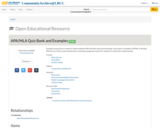
Examples and quizzes to reinforce understanding of APA and MLA style and formatting. A quiz bank is available in XHTML or Moodle XML format. These can be imported into a learning management system for students to check their understanding.

This course is designed to provide an engaging and personally relevant overview of the discipline of Abnormal Psychology. You will examine the cognitive and behavioral patterns which impair personal effectiveness and adjustment. Students will provide much of the substantive content and teaching presence in this course. Additional content has been curated from "The Noba Project (http://nobaproject.com/)" and "Abnormal Psychology: An e-text! (http://abnormalpsych.wikispaces.com/).
Openly-licensed course materials developed for the Open Educational Resources (OER) Degree Initiative, led by Achieving the Dream. https://courses.lumenlearning.com/catalog/achievingthedream
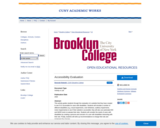
This activity guides students through the evaluation of a website that they have created to see if it is accessible for users with disabilities. Students will simulate a number of different disabilities (e.g. visual impairments, color blindness, auditory impairments, motor impairments) to see if their website is accessible; they will also use automated W3 and WAVE tools to evaluate their sites. Students will consider the needs of users with disabilities by creating a persona and scenario of a user with disabilities interacting with their site. Finally, students will write up recommendations to change their site and implement the changes.
Comments
Although this activity can be used in isolation, it is intended to be part of a series guiding students towards the creation of a front-end of a website. The series (all published as OER) consist of:
a) Needfinding
b) Personas, Scenarios and Storyboards
c) Front-end Website Design and Development
d) Accessibility Evaluation
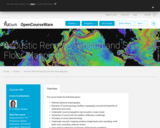
The course treats the following topics: - Relevant physical oceanography - Elements of marine geology (seafloor topography, acoustical properties of sediments and rocks) - Underwater sound propagation (ray acoustics, ocean noise) - Interaction of sound with the seafloor (reflection, scattering) - Principles of sonar (beamforming) - Underwater acoustic mapping systems (single beam echo sounding, multi-beam echo sounding, sidescan sonar) - Data analysis (refraction corrections, digital terrain modelling) - Applications (hydrographic survey planning and navigation, coastal engineering) - Current and future developments.
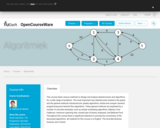
This course treats various methods to design and analyze datastructures and algorithms for a wide range of problems. The most important new datastructure treated is the graph, and the general methods introduced are: greedy algorithms, divide and conquer, dynamic programming and network flow algorithms. These general methods are explained by a number of concrete examples, such as simple scheduling algorithms, Dijkstra, Ford-Fulkerson, minimum spanning tree, closest-pair-of-points, knapsack, and Bellman-Ford. Throughout this course there is significant attention to proving the correctness of the discussed algorithms. All material for this course is in English. The recorded lectures, however, are in Dutch.
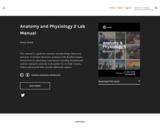
Anatomy and Physiology 2 Laboratory Manual is a guide for anatomy and physiology laboratory exercises. It includes dissection guidance with detailed images; instructions for physiology experiments including foundational content; and gross anatomy study guides for six body systems. Videos and tutorial links provide additional support. including studies in the following areas:
Endocrine
Blood
Cardiovascular
Respiratory
Digestive
Urinary
Reproductive
Fetal Pig Dissection

This is an Annotated Bibliography Assignment that helps students select excellent and appropriate sources for a major writing assignment.
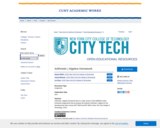
Arithmetic | Algebra Homework book is a static version of the WeBWork online homework assignments that accompany the textbook Arithmetic | Algebra for the developmental math courses MAT 0630 and MAT 0650 at New York City College of Technology, CUNY.
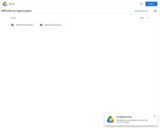
This is an exploration of visual art forms and their cultural connections for the student with little experience in the visual arts. The course includes a brief study of art history and in depth studies of the elements, media, and methods used in creative process and thought. Visual and performing arts are part of the Humanities: academic disciplines that study the human condition and, in addition to the arts, include languages, literature, law, history and religion. This course will teach students to develop a five-step system for understanding visual art in all forms based on description, analysis, meaning, context and judgment.Login: guest_oclPassword: ocl

Aswaat Arabiyya is an archive of 245 videos in Arabic, listed by difficulty level and accompanied by glossaries and four worksheets each that focus on every aspect of listening comprehension. Selections come largely from Arabic media, with some cultural presentations by native speakers. Videos cover the entire Arabic-speaking world and include MSA and different dialects. Materials are designed to be used both as in-class activities and homework assignments. Videos can be slowed down.
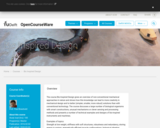
The course Bio-Inspired Design gives an overview of non-conventional mechanical approaches in nature and shows how this knowledge can lead to more creativity in mechanical design and to better (simpler, smaller, more robust) solutions than with conventional technology. The course discusses a large number of biological organisms with smart constructions, unusual mechanisms or clever sensing and processing methods and presents a number of technical examples and designs of bio-inspired instruments and machines.

This guide is a helpful way of remembering the criteria you should consider when evaluating information: Currency, Authority, Relevance, Documentation, Information Type, and Objectivity. CARDIO.
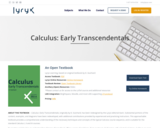
Calculus: Early Transcendentals, originally by D. Guichard, has been redesigned by the Lyryx editorial team. Substantial portions of the content, examples, and diagrams have been redeveloped, with additional contributions provided by experienced and practicing instructors. This approachable text provides a comprehensive understanding of the necessary techniques and concepts of the typical Calculus course sequence, and is suitable for the standard Calculus I, II and III courses.
To practice and develop an understanding of topics, this text offers a range of problems, from routine to challenging, with selected solutions. As this is an open text, instructors and students are encouraged to interact with the textbook through annotating, revising, and reusing to your advantage. Suggestions for contributions to this growing textbook are welcome.
Lyryx develops and supports open texts, with editorial services to adapt the text for each particular course. In addition, Lyryx provides content-specific formative online assessment, a wide variety of supplements, and in-house support available 7 days/week for both students and instructors.
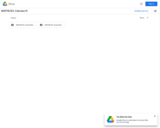
This contemporary calculus course is the third in a three-part sequence. In this course students continue to explore the concepts, applications, and techniques of Calculus - the mathematics of change. Calculus has wide-spread application in science, economics and engineering, and is a foundation college course for further work in these areas. This is a required class for most science and mathematics majors.Login: guest_oclPassword: ocl

This contemporary calculus course is the second in a three-part sequence. In this course students continue to explore the concepts, applications, and techniques of Calculus - the mathematics of change. Calculus has wide-spread application in science, economics and engineering, and is a foundation college course for further work in these areas. This is a required class for most science and mathematics majors.Login: guest_oclPassword: ocl
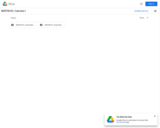
This course is an introduction to contemporary calculus and is the first of a three-part sequence. In this course students explore the concepts, applications, and techniques of Calculus - the mathematics of change. Calculus has wide-spread application in science, economics and engineering, and is a foundation college course for further work in these areas. This is a required class for most science and mathematics majors.Login: guest_oclPassword: ocl
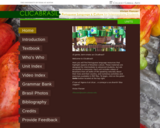
The Portuguese language lessons of ClicaBrasil highlight aspects of Brazilian culture. They are designed for intermediate to advanced students, but are accessible to everyone. Each lesson includes videos of Brazilians from all walks of life speaking naturally about their lives and their country. All lessons integrate reading, writing, listening and comprehension, grammar, vocabulary, oral communication and cultural activities with the videos. This is also available as a free PDF textbook and as print on demand.

This activity helps student design and develop a front-end of a website, from wireframes through HTML/CSS/Javascript. It includes design questions for students, including the invocation of Ben Schneiderman's eight golden rules for interface design.
Note: this activity assumes prior knowledge of web development. Since this activity is designed for an HCI course, with a focus on interface design, students are not expected to create a back-end for it. This activity can obviously be modified for a full-stack experience.
Comments
Although this activity can be used in isolation, it is intended to be part of a series guiding students towards the creation of a front-end of a website. The series (all published as OER) consist of:
a) Needfinding
b) Personas, Scenarios and Storyboards
c) Front-end Website Design and Development
d) Accessibility Evaluation

This document contains 5 contextualized examples of Radical/Rational Equations for MAT 035.